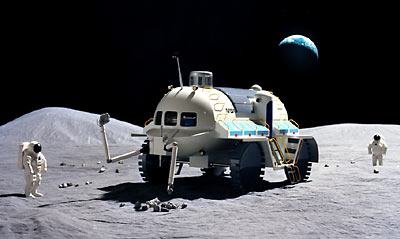|
|
 Can a caravan of vehicles, mounted with solar cells, provide continuous electric power on the Moon? (credit: NASA) |
Lunar solar: fixed and mobile
by Sam Dinkin
Tuesday, May 31, 2005
Should solar cells be fixed on the Lunar surface, or should they be on a railroad around the Moon?
The state of the art for electric cars on Earth is about 7 kilometers per kilowatt-hour (kg/kmh). Let’s make the heroic assumption that we could have the same efficiency on the Moon. We would have to travel sin(π/2 – latitude) • 3500 km each Lunar day or about 1 km/hr at 80 degrees latitude. For that we would need 1/7 of a kwh for a car’s worth of mass. Suppose an electric car that weighs 1000 kg can carry 500 kg of solar panels on Earth. That corresponds roughly to the batteries and payload of electric cars currently in use. The “solar train” would be in trouble regardless of the latitude on Earth. The payload mass would have to exceed the car mass in order for the system to exceed the efficiency of two solar cells on opposite sides of the pole. On the Moon, however, we can carry 3,000 kg of solar panels with the same electric car chassis. Suppose it takes 20 kg/kw. Then we need only about 3 kg worth of solar cells to power the car on the Moon.
Focusing on the vehicle mass, we do not have such a big margin to work with. Even taking into account that fixed solar panels need the sun above the horizon and only work about 3/7 of the time, we do not have much efficiency gain to work with. We have spent 1/4 of any possible benefit on the vehicle before we have considered the following:
- Higher mass for rugged mobile solar panels;
- Secondary systems in case of breakdowns;
- Repair;
- Higher development costs;
- Pairs of tracking solar panels have a simpler mechanism, fewer structural requirements, and a more graceful failure potentially cutting an additional 1/12 of the benefit
That is, for our 3,000 kg of mobile solar panels to be better than 6,000 kg of fixed solar panels, we need the amortized Earth materials to make the road, repair the moving parts, develop the system, scout the route, and secondary systems in case of failure to be less than 3,000 kg. If there is 99% reliability and a passing lane, we can probably break even with just a few secondary cars for 100 primary solar train cars and a 200,000-kg repair shed including people. For a single car, the weight of the secondary system would be as much as the primary.
| I think we can put the solar train idea on the shelf during colonization. |
A railroad that is smooth will reduce the requirement for additional mass for ruggedness, lower development costs, and reduce the likelihood of breakdowns. If we have a smooth railroad, however, we have the makings of a power line. A power line is less mass than a rail. A railroad had better be built out of lunar materials or it will be too much mass for the solar train to be workable. Even a bulldozed regolith road would be hard to complete for less than the cost of stringing a power line. In any case, we need a power line to harvest the power from the solar train. With a power line in place, the two flimsy solar cell solution on opposite sides of the pole is feasible. No moving parts. We need 1/π as much cable. With a linear track over the pole, the solar train can avoid the geometry penalty, but we are still only getting a small benefit in terms of energy in exchange for a big cost in terms of simplicity and reliability.
I think we can put the solar train idea on the shelf during colonization. When the mass calculation is for a safe, high reliability system including the weight of the secondary systems, it seems pretty clear that the stationary system is the winner.
The good news is that solar powered transport should be highly functional (during the day) given the high energy density and high payload in Lunar gravity. Lunar solar trains will be more of a lifestyle choice when repair becomes as routine as towing an electric car on Earth.
Sam Dinkin is a regular columnist at The Space Review. He can be reached at (888) 434-6546 and thespacereview@dinkin.com.
|
|
